Red-cockaded Woodpeckers (Dryobates borealis)
The red-cockaded woodpecker (RCW) is a member of the family Picidae and one of eight woodpecker species native to South Carolina. Similar to other members of the woodpecker family, this small bird has a chisel-like beak used for excavating holes and strong claws that enable it to move along the side of a tree. Male and female red-cockaded woodpeckers look alike, apart from the characteristic feature for which they are named. Males have a red cockade, a streak of red feathers behind the eye, but this feature is small and difficult to see. Both males and females have black heads with white cheek patches, and their backs are barred with black and white. Their underside is white, and they have black spots on their flanks. RCWs are habitat specialists, residing year-round in open, mature pine forests that lack a dominant hardwood midstory, such as those maintained by periodic wildfires. The red-cockaded woodpecker (RCW) is a member of the family Picidae and one of eight woodpecker species native to South Carolina. Similar to other members of the woodpecker family, this small bird has a chisel-like beak used for excavating holes and strong claws that enable it to move along the side of a tree. Male and female red-cockaded woodpeckers look alike, apart from the characteristic feature for which they are named. Males have a red cockade, a streak of red feathers behind the eye, but this feature is small and difficult to see. Both males and females have black heads with white cheek patches, and their backs are barred with black and white. Their underside is white, and they have black spots on their flanks. RCWs are habitat specialists, residing year-round in open, mature pine forests that lack a dominant hardwood midstory, such as those maintained by periodic wildfires.
The range of the RCW extends from southeastern Oklahoma and Maryland to the Gulf coast and central Florida. Many of the RCW in South Carolina reside in Francis Marion National Forest, while others inhabit the Sea Islands, coastal and sandhill regions. Historically, RCW may have inhabited the area that has become the ACE Basin, though they were absent for many years. Since the South Carolina Department of Natural Resources (SCDNR) began RCW conservation, populations have been re-established in the ACE Basin. In all, over 1,400 RCW breeding groups can be found in South Carolina on state, federal, and private lands.
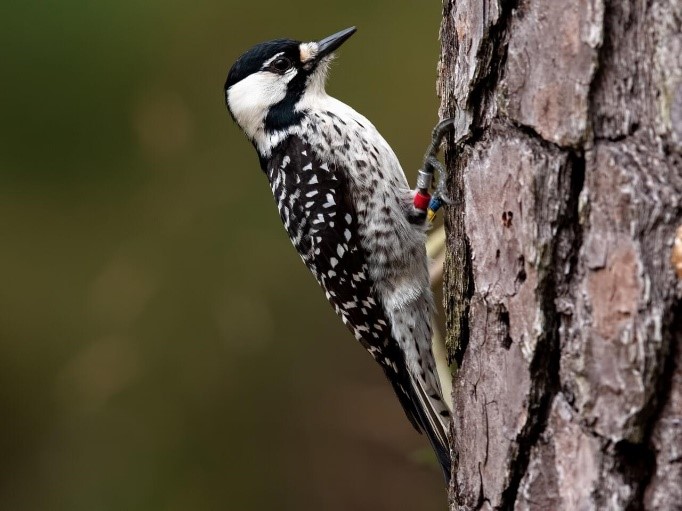
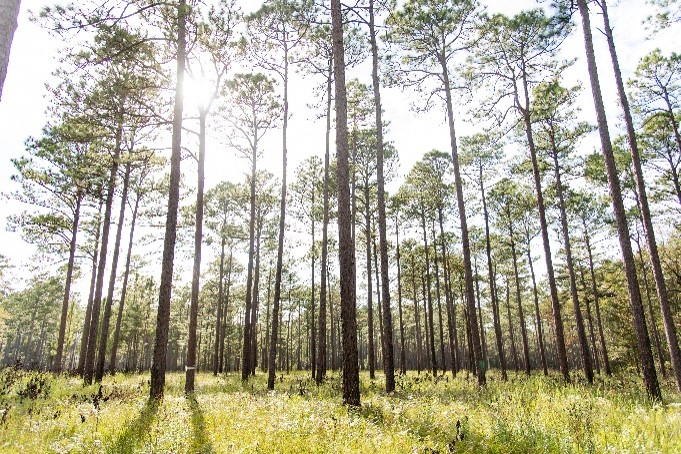
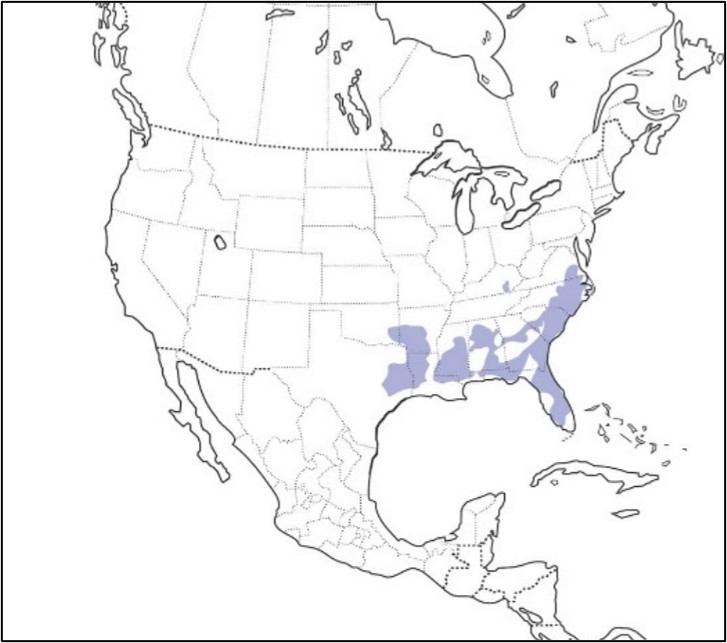
Left: Mature pine habitat is preferred by red-cockaded woodpeckers for nesting and foraging. The canopy is open and midstory vegetation is minimal, allowing diverse understory plant and insect species to establish.
Biology
Red-cockaded woodpeckers are the only woodpeckers to excavate a nest cavity in a living tree. Trees suitable for cavity building are typically infected with red heart disease, a fungal infection that causes the core of the tree to rot, which eases excavation for the woodpeckers. However, excavating a single cavity may still take multiple years. After completion, the birds proceed to peck smaller holes around the cavity to encourage tree sap, or resin, to ooze down the trunk of the tree, which serves as a deterrent for potential predators such as rat snakes or corn snakes. RCWs are considered a keystone species, as the cavities they excavate also provide shelter and nest sites for a wide variety of vertebrates, including flying squirrels, eastern bluebirds, nuthatches, and snakes.
RCWs are diurnal, meaning they are active in the daytime, and return to their cavity to roost every night. These birds are cooperative breeders and live in family groups of four to six individuals. Family groups consist of the male and female breeding pair and several helper birds, usually the male offspring from previous years. Helpers assist in incubating eggs, feeding the young, and excavating new cavities. If one of the birds in the mating pair dies, helpers or offspring from another nearby cluster will typically fill that role in subsequent years. Each member of the group has its own roost cavity. These cavity trees are typically located near each other and are referred to as a cluster. An RCW group occupying a cluster can utilize 200+ acres of pine woodlands for nesting and foraging. These woodpeckers feed on larvae of wood-boring insects, grubs, beetles, spiders, and other arthropods. Adults occasionally eat berries of wax myrtle, blueberry, poison ivy, and sweet bay.
RCWs nest in the spring, typically late March to late May. Breeding females lay two to four white eggs. Young hatch 10-12 days after egg-laying is complete and spend approximately 3 weeks in the nest before fledging. Once fledged, juvenile RCWs may stay in the cluster and become helper birds the next breeding season or leave the cluster in search of a mate to start a new cluster.
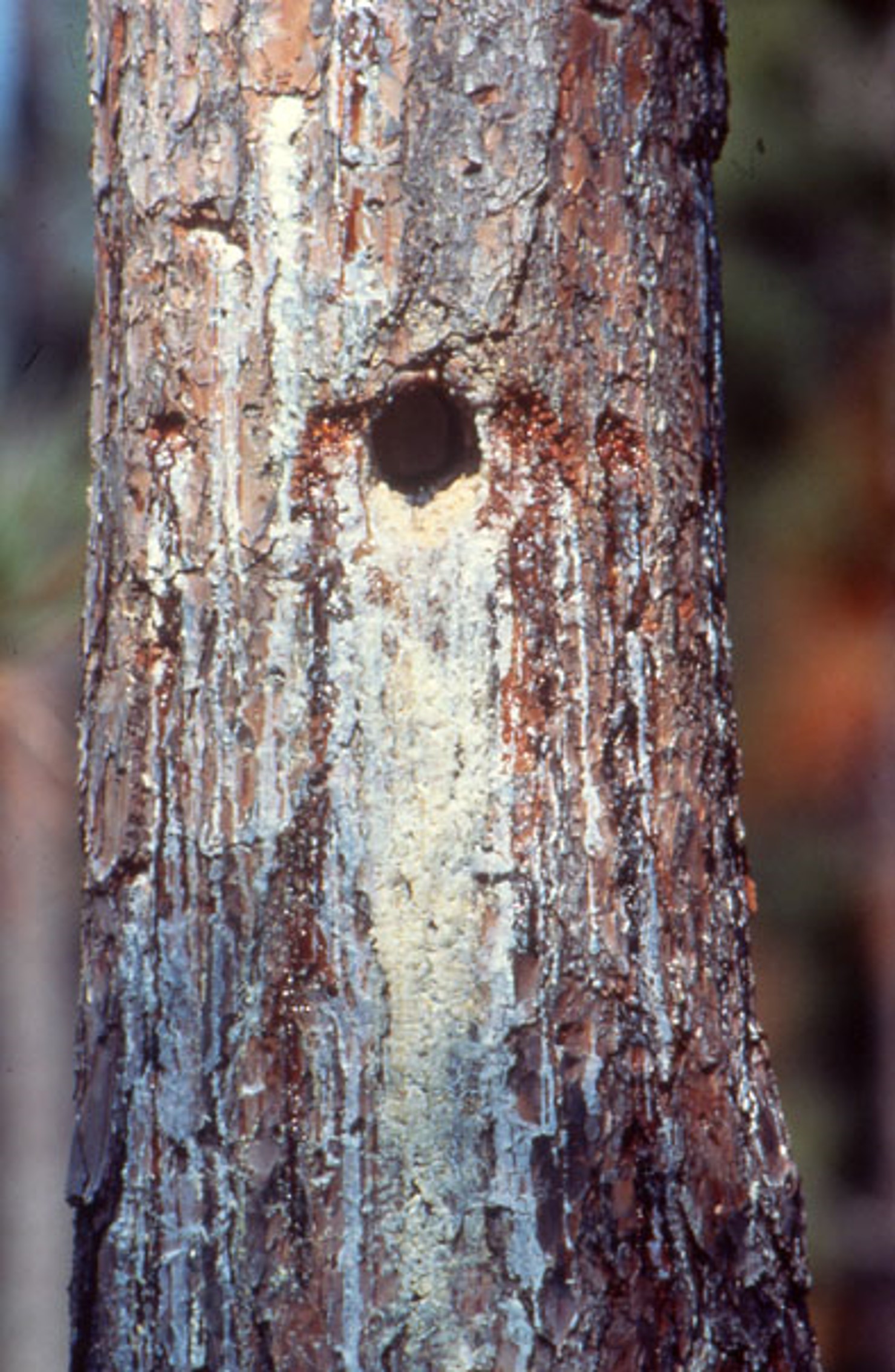
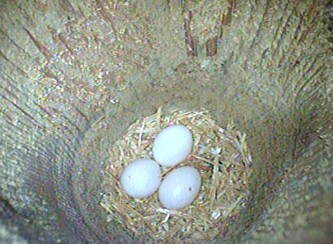
Left: An active woodpecker cavity in a longleaf pine. Resin wells have been constructed around the circumference of the tree to prevent predators from scaling the trunk.
Conservation
The red-cockaded woodpecker is considered endangered in most states where it occurs, including South Carolina. By 1970, the species had declined to fewer than 10,000 individuals in widely scattered, isolated and declining populations. The RCW is listed with 19 other extant avian species as a species of highest conservation concern on the Partners in Flight Watch List. The primary factor leading to its decline is habitat loss. Because this species is so specialized with respect to habitat requirements, they are extremely vulnerable to land-use changes caused by historic pine logging and contemporary forestry practices. Pine stands are generally harvested before reaching the age necessary for cavity excavation and stocked in a way that does not promote open-canopy conditions or a lush understory. Thus, breeding groups are often limited by low availability of cavity trees and/or poor-quality foraging habitat. Thankfully, there are a number of management practices that biologists and land managers commonly employ to improve nesting and foraging habitat for RCWs, as well as to assess breeding success and population dynamics of active groups.
Land Management
Land management is a critical component to the persistence of red-cockaded woodpeckers on the landscape. Historically, southeastern pine ecosystems were maintained by lightning-caused wildfires and prescribed burns by indigenous peoples. Fire, in addition to windthrow from storms, promoted an open canopy, minimal midstory, and an understory vegetative community that supported diverse plant and insect food resources. Prescribed fire has been re-introduced across the southeast to recreate these historic conditions and to improve habitat quality for RCWs, as well as a suite of other game and non-game wildlife species. In addition, chemical or mechanical methods are used to remove midstory trees and shrubs that are too hardy to be managed by fire. Another important aspect of land management for RCWs is increasing timber rotations so that pines can grow to sizes and ages suitable for cavity excavation.
Artificial Cavities
Inserting artificial cavity boxes into live trees can immediately benefit red-cockaded woodpecker populations with access to few natural cavities. Since the early 1990’s, artificial cavities have been used to increase the number of suitable cavities in existing clusters, restore clusters after a major storm or wind event, and establish new recruitment clusters in suitable, but unoccupied breeding habitat.
Monitoring
Biologists monitor red-cockaded woodpeckers across South Carolina on both public and private lands. Nest monitoring is a common way to assess which family groups in a population are successfully breeding and to calculate hatching and fledging rates. Because RCWs nest in cavities from 15 to over 60-feet high, biologists must use specialized equipment to monitor nest development. To reach high cavities, a camera is attached to a telescoping pole, raised to the height of the cavity, and inserted directly into the cavity entrance. The contents of the cavity can be determined from the base of the tree using a wireless monitor. Nests are monitored from the egg-laying stage until nestlings fledge.
In some monitored RCW populations, nestlings are banded with an aluminum U.S. Geological Survey band, and a series of color bands that give the birds an individually recognizable combination. Banding allows biologists to study dispersal, behavior, survival, and reproductive success of individual birds, as well as census the number of birds within a family group or population. In South Carolina, many other species of birds besides RCWs are banded each year, including bald eagles, wood duck, mottled duck, mourning dove, passerine birds, and shorebirds.
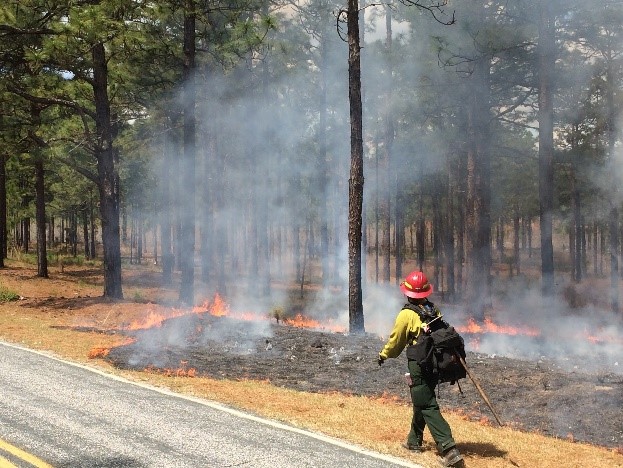
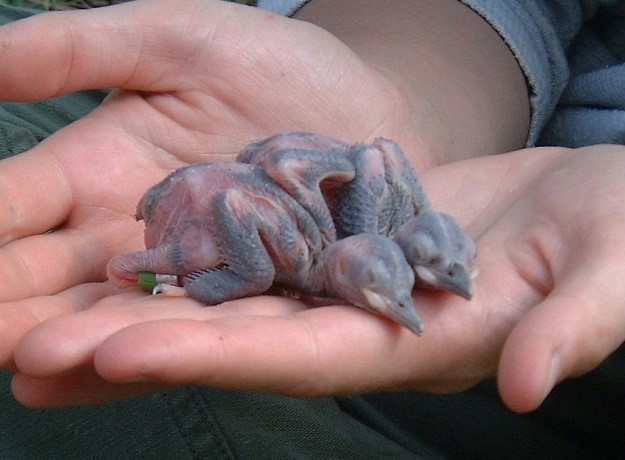
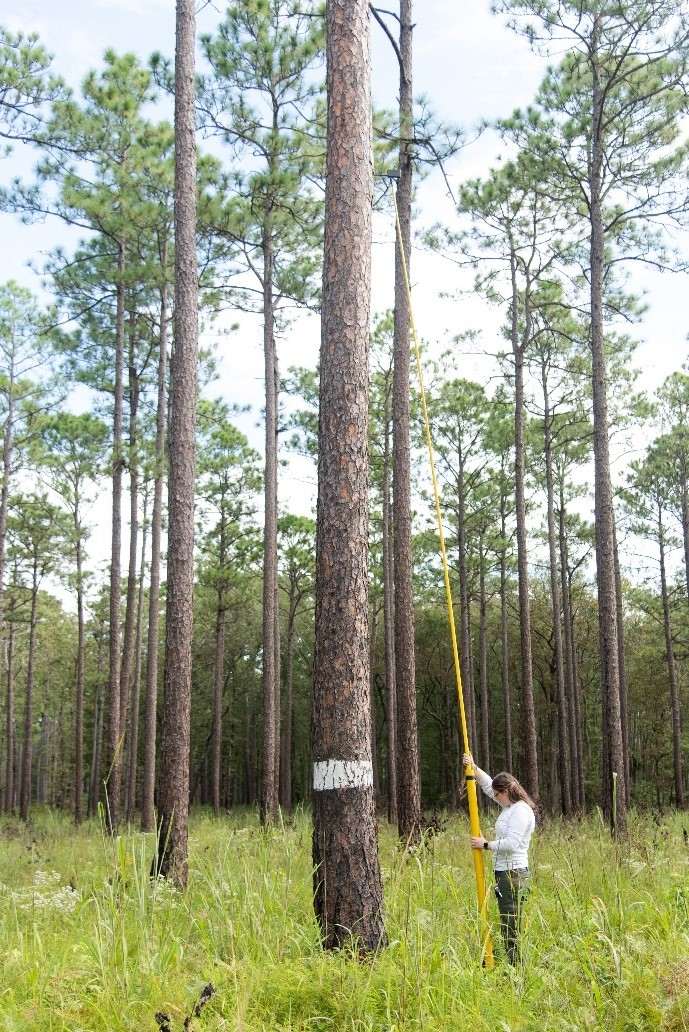
Current Legislation
Federal Protection
Red-cockaded woodpeckers were listed as endangered in 1970 and received federal protection in 1973 when the Endangered Species Act was passed. RCWs currently remain protected under the Endangered Species Act. This act prohibits take where “take” is defined as “pursue, shoot, shoot at, poison, wound, kill, capture, trap, collect, destroy, molest or disturb”. The Endangered Species Act outlines the federal prohibitions regarding the “take” or “disturbance” of an endangered species, including their parts, nests, eggs. For more information on prohibited acts on endangered species, please see Section 9 of the Endangered Species Act.
State Protection
The South Carolina Department of Natural Resources Heritage Trust program describes red-cockaded woodpeckers as imperiled state-wide because of rarity or factor(s) making it vulnerable (S2) while globally the species is ranked as vulnerable (G3). RCWs are listed as a state endangered species (regulation 123-150 Article 5 pages 67-85) and receives state protection as a nongame species (law 50-15-10) in South Carolina.
South Carolina Safe Harbor Program
The Red-cockaded Woodpecker Safe Harbor Program is administered by SCDNR and was authorized in a 1998 agreement between the U.S. Fish and Wildlife Service and SCDNR under the Endangered Species Act. Under the Endangered Species Act, private landowners have a legal obligation to protect RCW and their habitat. The goal of the Safe Harbor Program is to provide conservation benefits to RCW while removing regulatory restrictions to landowners who are voluntarily restoring or enhancing suitable habitat through improvement projects, such as prescribed burning on hunting plantations. Landowners interested in restoring or enhancing upland pine habitat, but concerned about additional regulatory restrictions if their RCW population increases are encouraged to seek enrollment in the program. Enrolling in Safe Harbor is voluntary, and a landowner can withdraw from it at any time. For more information on the Safe Harbor Program, see an in-depth overview of eligibility requirements.
References and Further Reading
Jackson, J. A. (2020). Red-cockaded Woodpecker (Dryobates borealis), version 1.0. In Birds of the World (A. F. Poole and F. B. Gill, Editors). Cornell Lab of Ornithology, Ithaca, NY, USA.
K. V. Rosenberg, J. A. Kennedy, R. Dettmers, R. P. Ford, D. Reynolds, J.D. Alexander, C. J. Beardmore, P. J. Blancher, R. E. Bogart, G. S. Butcher, A. F. Camfield, A. Couturier, D. W. Demarest, W. E. Easton, J.J. Giocomo, R.H. Keller, A. E. Mini, A. O. Panjabi, D. N. Pashley, T. D. Rich, J. M. Ruth, H. Stabins, J. Stanton, T. Will. 2016. Partners in Flight Landbird Conservation Plan: 2016 Revision for Canada and Continental United States. Partners in Flight Science Committee. 119 pp
U.S. Fish and Wildlife Service. 2003. Recovery plan for the red-cockaded woodpecker (Picoides borealis): second revision. U.S. Fish and Wildlife Service, Atlanta, GA. 296 pp.
U.S. Fish and Wildlife Service. 2019. Species status assessment report for the red-cockaded woodpecker (Picoides borealis). Version 1.3, April 2020. Atlanta, GA. 198 pp.
